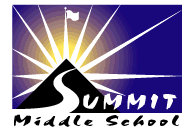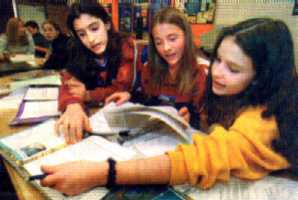

January 5, 2004
Boulder Daily Camera
by Amy Bounds

Above, from left, Debra Abedzadeh, Elizabeth Fleagle and Rachel Robinson work as a science team at Summit Middle School last month.
 At left,
Summit teacher Haydee Phelps explains fossils to seventh-graders Anne Smartt,
Jen Godina, Martha Carol and Megan Kostanick during an earth science class.
At left,
Summit teacher Haydee Phelps explains fossils to seventh-graders Anne Smartt,
Jen Godina, Martha Carol and Megan Kostanick during an earth science class.
Photos by Cliff Grassmick
Seventh-grade students spent a recent class at Summit Middle School sifting through gravel to uncover tiny fossils and using guide books to help identify and classify the ancient creatures.
Their teacher, Haydee Phelps, talked them trough the classification system and urged one to figure out on her own if a pointy, black sliver was really a shark tooth. The class can be challenging.
"It's hard here," said student Sean Bullock as he searched for a match to a fossilized trilobite (an extinct marine invertibrate) in a guide book. "We kind of move fast."
Summit's academic rigor has paid off.
The school recently received the national Blue Ribbon School of Excellence Award through the federal No Child Left Behind Act, recognizing Summit as one of the top-performing schools in the country. Boulder Valley's first charter school, Summit was the only Colorado middle school to receive the award.
The Blue Ribbon program recognizes schools that make significant progress in closing the achievement gap or, as in the case with Summit, whose students score in the top 10 percent on state tests. The schools are nominated by the state school chief and submit applications to the U.S. Department of Education.
"You stand as a model for many other schools," Pat Chlouber, the regional representative for U.S. Education Secretary Rod Paige, told Summit's teachers.
Chlouber visited the 300-student school last week to present a picture from the award ceremony in Washington, D.C.
"We do well by the kids who come here," said Summit parent and charter board member Barb Kostanick. "It's really wonderful that a school that's 8 years old accomplished so much."
Some of the reasons school officials give for Summit's success include strong parent involvement, top-notch teachers, clearly defined standards, and a relatively small school with small class sizes.
Sixth-grader Kelly Hartzell said the school's size was one reason she enrolled.
"I like how the teachers walk around and help kids when they need help," she said. "You can make lots of friends. You don't have to feel embarrassed or scared about being new."
Summit Principal David Finell said getting so many of the school's students to perform at a high level academically requires setting high expectations and providing lots of support, including after-school tutoring and literacy programs.
"Our philosophy is that children will rise to the level of expectation," he said.
Students are assigned to classes based on ability and interest. The school offers seven different levels of math and multiple levels in the other core subjects. All students take a foreign language.
The school's reputation for pushing students is what drew eighth-grader Allison Ferris.
"It's really challenging," she said. "It's fun."
Former unsuccessful Boulder Valley School Board candidate JoElyn Newcomb was irked by the above article on Summit:
January 10, 2003
Boulder Daily Camera
CHARTER SCHOOLS
by JoElyn Newcomb
Boulder
The latest article on Summit Charter School really irked me. Yes, they received an award for having students who test in the top 10 percent. However, they "succeed" by attracting high achieving students who are not in special ed or eligible for free lunch.
Look at the numbers: In eighth grade reading, Platt/CHOICE 90 percent proficient and Summit scored 97 percent. Platt/CHOICE has 10 percent special ed and Summit has 1 percent; Platt/CHOICE has 3.6 percent free lunch and Summit 0.6 percent. In eighth grade writing, Southern Hills scored 84 percent proficient while Summit scored 91 percent. Southern Hills has 17.2 percent special ed and 4 percent free lunch compared to Summit's insignificant numbers. It's obvious that Platt/CHOICE and Southern Hills are providing a superior education to all students. Southern Hills and Platt/CHOICE deserve the award.
Summit is outstanding in one area that raises eyebrows -- fund raising. They intend to raise $100,000 this year from their community, or approximately $350 per student. They just won a $64,900 grant from the conservative Walton Family Foundation -- Wal-Mart money. Quite a chunk of change -- $164,900. The Southern Hills PTO and Platt/CHOICE PTO plan to raise between $20,000 and $30,000. They each educate about twice as many students. Summit is spending substantially more per student and that calls into question the Colorado constitution's requirement of a thorough and uniform system of free public schools.
If you look at the prestigious universities that our high-school graduates attend, you'll see that they attended each and every BVSD middle school. To provide an excellent learning environment for your child, you do not have to choose an elitist charter school like Summit. Look closely at Platt/CHOICE, Southern Hills, Manhattan, Angevine, Casey, Centennial, Louisville, or Broomfield. Great kids attend each of those schools.
Summit alumni defend Summit on their own in this unpublished rebuttal mailed to former unsuccessful Boulder Valley School Board candidate JoElyn Newcomb:
January 9, 2004
Dear Mrs. Newcomb,
In your January 8 open forum letter, you expressed your dislike of Summit Middle School, which you state "calls into question the Colorado constitution's requirement of a thorough and uniform system of free public schools." As former Summit students now attending Boulder High School, many by choice through open enrollment, we believe that your letter neglected many important issues regarding Summit's proven academic excellence.
While Summit encourages families to donate to the school's outstanding programs, Summit MUST have additional funds to cover the discrepancies that exist between BVSD middle school facilities. Have you ever visited Summit? The Majestic Heights facilities in which Summit is housed was built to accommodate a small population of elementary school students. Now, Summit's 300 students rely on a single space to serve as the cafeteria, gym, and auditorium (Summit students term this space the "cafegytorium"). In a "thorough and uniform system of free public schools," would a school need to fundraise to equalize facilities to those of other schools in the district? Summit does not force families to donate, but relies upon the community for the basic resources that the district is unwilling to provide.
While other BVSD middle schools purchase textbooks and other materials with donation monies, Summit must save up for a new gym, library materials, textbooks, and the funds to rent Boulder High School's auditorium to hold school events such as concerts. It is indeed sad that Summit must struggle to have the capacity to host a basketball game, while Southern Hills enjoys the benefits of housing 480 students in a facility that was built to accommodate 630 (source: BVSD facilities webpage). As Summit turns closets into locker rooms and students walk outside between classes whatever the temperature, since a single hallway cannot possibly fit 300 teenagers, other BVSD middle schools hold P.E. classes on real volleyball courts. The rest of the students enjoy lunch in a cafeteria which, amazingly enough, is not scheduled to host that afternoon's guest speaker (lectures occur in the newly-carpeted auditorium, which seats most of the student body). Is this educational equality?
Summit attracts highly motivated students; this is undeniable. Yet why do these students feel compelled to consider Summit's programs? In many cases, incoming sixth graders recognize the fact that neighborhood schools do not meet their academic needs. Is this a result of "stratification" -- students open enrolling in order to avoid contact with students of a different economic background? Certainly not. These students, who value education and the opportunities that Summit provides, recognize the need for a curriculum in which critical thought is the key objective. Students find a great diversity of thought at Summit, where teachers encourage students to stretch beyond themselves through writing, research, and discussion. Summit faculty and students value each individual for his/her unique perspectives, and students can comfortably challenge these perspectives through constructive criticism in order to solidify even stronger arguments, whether in a geometry proof or an English paper.
Summit teachers demand and command respect, using advanced methods to evaluate students and provide feedback on academic progress. Most of all, by becoming interested in challenging coursework, even students who enter Summit as the "non-academic sorts" leave the school craving to learn more and further explore their newfound talents. Rather than beating at Summit with illogical arguments and characterizing all Summit students as "elitist" (logical fallacies, incidentally, are covered at Summit so that students do not use broad generalizations, personal attacks, and emotional arguments), BVSD should seriously examine what makes Summit such an exceptional learning environment. BVSD should then look at the ways in which Summit's positive standards can be implemented at other BVSD schools.
We invite you to visit Summit and view firsthand the ways in which the school meets and exceeds the standards of any other BVSD middle school, producing a diverse and insightful student body.
-- Katherine Hermann (and 13 other former Summit students)